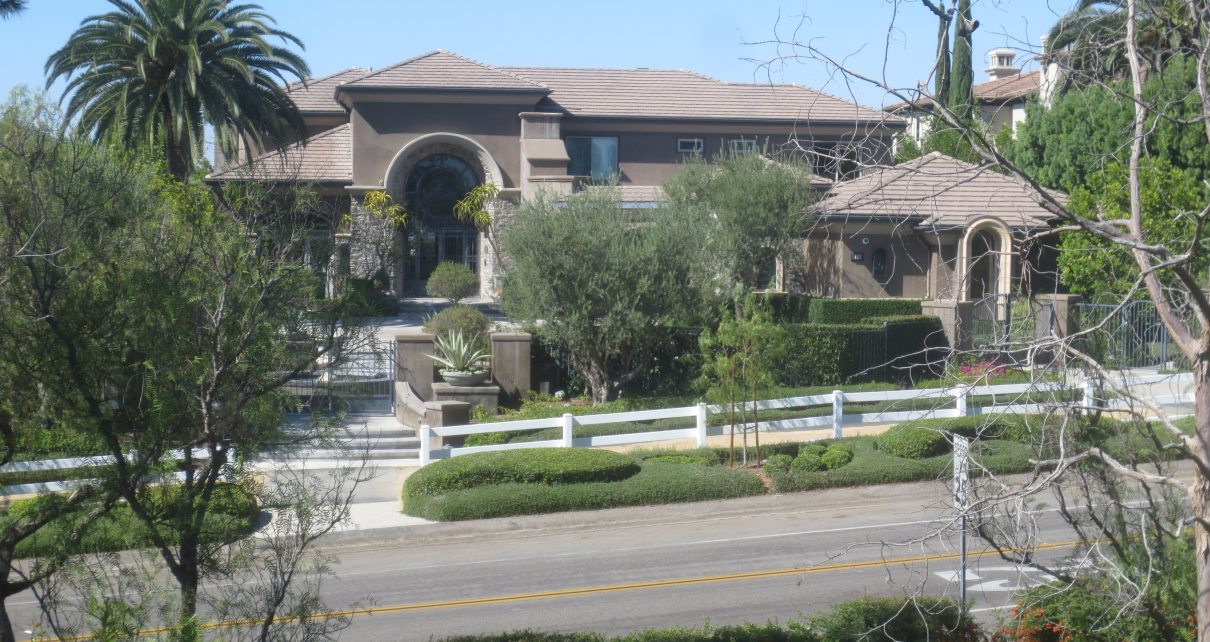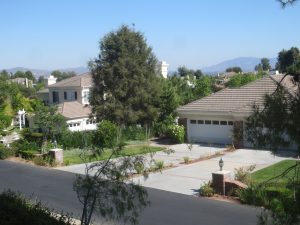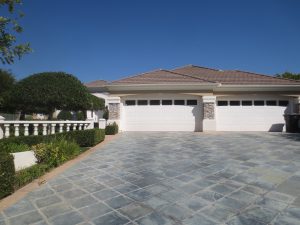
A typical McMansion in Fullerton. (Evan Symon for California Globe)
The Housing Crisis Part III: Fullerton
The Globe takes a look at McMansions and their effect on the crisis.
By Evan Symon, October 8, 2019 6:05 am
While driving down a few streets in the suburban Orange County city of Fullerton, an unusual by-product of the housing crisis presented itself. Rows and rows of large houses known as ‘McMansions’ built within the past 20 years lined the streets, many with ‘For Sale’ signs pounded into the front yard.
A small stretch of street nearby the California State University Fullerton campus brought a succession of three houses with signs out front.
“There’s another,” said “Mary Jo”, an Orange County realtor who did not want her name used, pointing at another of the large houses, this one advertising over 4,000 square feet. “I had a showing there last week and some people left without walking out of the foyer.”
“Younger people just don’t want them,” she added, shaking her head as another large McMansion came into view. “That’s why so many of these houses are empty.
We have all of these empty houses, and yet people are sleeping in the street or can’t afford to buy a house or rent.”

Despite only being a phenomenon since the 1970s, McMansions dot across California, with large clusters cropping up in the Bay Area, around Los Angeles, and in San Diego.
Mary Jo’s Orange County has become famous for McMansions thanks to Realty housing shows on HGTV such as Flip or Flop and comedies such as Arrested Development.
But what is a McMansion, and why does no one want them?
The Globe sat down with Kate Wagner, an architectural writer and blogger, whose website, McMansion Hell, has made her one of the de facto experts on McMansions in the United States.
“McMansions are typically built between the 1970s and the present,” Wagner told the Globe. “They’re over 1,000 square feet and are designed from the inside out.
They have irregular rooflines, big open foyers, unusual floor plans, a lot of extra space, large attached garages, and an unusual mix of architecture.”
Mary Jo also gave some details.
“They’re made to look like a small estate. In listings, we never say “McMansion”, but we’ll go with any other type, like “A large Tudor.” And these houses will also point out exclusivity, like gates or fountains.”
For many these houses were built to become their ‘affordable’ mansions.
“McMansions were built new as a custom dream home,” Wagner explains. “Most of these houses were built in planned subdivisions built strategically in a suburb. For families they saw them as reliable, with safety and their children in mind.”
McMansions remained huge throughout the ’80s, ’90s, and into the 2000s. But after the Great Recession in 2008 and the collapse of the housing market, the past decade has seen demand for McMansions go into freefall. And despite a housing market recovery and a fast-growing need for housing in California, they are still largely not selling.
Part of it is a generational gap.
“Younger people, like millennials, can’t afford this or want a smaller house,” said Mary Jo. “Even if they can afford it. They instead want a ranch or an older home. I’ve had to talk with many clients in their 60’s and 50’s about this, and they don’t see why nobody would want their home.”
Wagner agreed, but said that it ran deeper than that.
“It’s a generational issue,” explained Wagner. The market has shifted away from house accumulation and wanting large unused rooms. Younger people can’t buy that and that has made downsizing popular.
You also have to remember that many of these homes were custom built. These are dream homes.No one wants to own someone else’s dream home.”
Many McMansions also have a stigma of being cheaply made. Mary Jo has been selling houses throughout Southern California for years and notes that older houses she sells come in much better condition.

“I’ve shown houses, both in Orange and LA, where ten-year-old houses were literally crumbling apart,” remembered Mary Jo. “A lot of these houses were built so quickly, or had unusual parts on them, that builders were often rushed or couldn’t make heads or tails of what to do next. So some buildings have cracks in them ten years later. Some don’t have insulation because it was simply forgotten. Odd angled walls are coming apart because the construction crew didn’t know how to handle it. High ceilings get mold or permanent stains because they couldn’t be reached. Cheap plaster, cheap wood. Thin walls. You name it and chances are at least a few houses I’ve seen like this have had it.”
“There was a somewhat infamous house in Irvine that had a plant outside growing inside the house,” said Mary Jo. “The sealing on one of the windows was evidently poor in a place, and this vine dug itself through. The bank had taken that house during the crisis, so when the bank decided to sell it as is, the company I was working forgot it. I was greeted by that vine in a living room. It was about three feet long and starting to take over the carpeting.”
“Most houses, well, you can see the roof damage in Google Earth in some cases. They just weren’t built right. The fake weathering of some of the bricks was torn away for real weathering sometimes.”
“The biggest thing is that water damage comes out easier. A lot of these houses get water damage much sooner than the houses built in the ’40s or ’50s I show.”
“These were built quickly and cheaply, and you can tell. I can never mention that when showing houses, but there you go.”
“Much of that bad upkeep comes straight from an easily avoidable problem – designs in McMansions that made them ‘unique’ but in reality are not architecturally sound.”
“McMansions are prone to a lot of problems,” noted Wagner. “There’s water damage, vinyl siding not being durable, unusual and complex rooflines, and awkward shapes of the homes. These homes were marketed as being low maintenance, but it was actually very high. The awkward roof lines led to a lot of wear and tear, and roofs needed to be replaced at least every 20 years. And what happened was a lot of damaged roofs in these houses.”
“And that is just the roof. There was no culture of maintenance, and you just had a lot of wear on these houses.”
California was hit hard by all of those issues, in addition to a lot of overlooked practical matters. Keeping the air conditioning or heat on in a 5,000 square foot house is expensive, with large houses and yards costing a small fortune in taxes.
Despite some reports saying they are back, first-hand accounts in California are painting a bleaker picture.
All of this has spiraled to a large number of hard-to-sell homes that are overvalued, expensive, that the owners don’t want to take a loss on, and younger people don’t want to buy.
It’s difficult to estimate the average number of unsold McMansions, but real estate agents have reported that McMansions are hard to turn around. So much so that some neighborhoods are estimated to have half of their McMansions unsold or in foreclosure.
“Some of our buyers only hang on to them for a year,” said Mary Jo. “It’s the crisis hitting us. People can’t afford these, raise the money for a decent down payment, but then after a job loss or plain can’t affording it do to other higher costs, they foreclose or they sell the house.”
“I can’t say how many are unsold in California, especially since many of them go in and out of being sold or on the market. But in Orange County, it’s at least 10 to 15 percent of McMansions in states of not being sold in some developments, like if it’s in foreclosure or escrow. But it depends, become some neighborhoods have a much higher rate,” Mary Jo explained, motioning to the row of houses with signs in front of them down the street. “That’s a lot of families, a lot of people, that could have them but don’t.”
Solutions to the McMansion problem in California aren’t great either.
“Ranch and farmhouse styles are seeing a resurgence,” said Wagner. “The HGTV style. No one wants McMansions anymore. They want smaller. But realtors keep pushing these with the same buzzwords they used twenty years ago.”
“As people who own them age, they either won’t be selling or will be selling for way less. It will create a small real estate crisis.”
So what can be done?

Los Angeles has been severely limiting them in recent years due to the waste on space and the number sitting vacant, as have many Californian cities. No city wants a lot of large unsold houses next to a homeless encampment who is there solely because they can’t afford rent.
There IS a demand for larger houses, but consumers want newer houses in more traditional or modern styles. Some of these are simply a variant on the McMansion, with all the associating problems with it.
Adapting these vacant McMansions to apartments has been considered, much how former industrial buildings are converted to other uses. But this has largely been ruled out.
“Because the layout is so large, it’s hard to adapt McMansions to apartments to apartments,” Wagner explained. “The cost outweighs profit.”
Mary Jo noted a small but growing trend – making “McRanches”.
“These McMansion they couldn’t sell, they’ll saw off the top of the house, the entire second floor. With permits of course. Then they’ll re-roof it and suddenly it’s a very large single floor house. It goes for less too.”
“These are still hard to sell, but it’s easier because we can say they’re a more luxurious starter home.”
Wagner also noted all the other methods that are being tried.
“Many have been slashing prices like crazy and trying to sell them as always like a country club membership.”
There have been some that have been attempted to be made into a rehabilitation center for alcohol or drugs, but it’s not a viable solution as only a small subset work for this. And with rich neighbors they would never allow this.”
“Some have also tried tearing them down for green space, but that’s losing a lot on property taxes.”
The only real solution for many realtors and real estate agents is to do as they have always done, as Kate said, and try to make it feel exclusive.
“It only works so much,” replied Mary Jo, stopping at an open lot at the end of the street that hadn’t been touched since 2010. “You can have a gated community, with beautiful views, in a good school district, and yet it won’t matter, because you still have a house that isn’t wanted at the end of the day.”
“This is definitely contributing to the crisis. I mean, these are all empty houses. And yet there are families who can’t afford it and need to rent a small apartment instead of getting a decent rent on a house.
No sane person would see all of these houses for sale, see the prices, and then see all the people being driven out or unable to afford a house and not see the connection.
These are houses open for a type of wealthy person who doesn’t really exist in this day and age.”
Housing Crisis Series:
- Man Who Broke Into L.A. Mayor’s Home to Receive Probation, Mandatory Drug Treatment - July 25, 2024
- California National Guard Counterdrug Task Force Seizes nearly $4 Million Worth Of Fentanyl In June Following Ramping Up Of Actions - July 24, 2024
- San Francisco’s Guaranteed Income Programs for Trans People to End - July 24, 2024





The homeless articals are everywhere, but I havent read one that has mentioned the huge problem of the ” Working Homeless” The families that lost their house or apt and have moved into motels. The cheapest motels run approx $80/$95 a night. Shelters are only available to people who can “check in” in the early afternoon in order to secure a space. The working homeless that has bad credit and cannot get an apt because of their credit score but are paying $2,600.00 a month for a motel room that has a kitchenette. Taking all their money just to keep a roof over tneir heads. We had to leave our motel becuse we ran short on funds. We had no money, no food and no place to stay until payday. We went to social services and explained our position. The worker we spoke to said we fell into the ever growing ” Working Homeless” group that does t qualify for any help. Why, because we work and have an income. I was told that if we were Drug addicts or a victim of demestic violence or pregnant, there were hundreds of organisations to help. But nothing for a family that gets up everyday and goes to work. Even the food pantry`s are all during the day on a tuesday or thursday. I was told by a Social Services worker are situation is becoming more and more common. Just because you aren’t sleeping on the sidewalk dosent mean your not homeless.
And goes to work e edg day